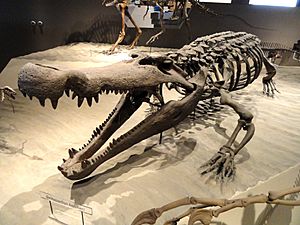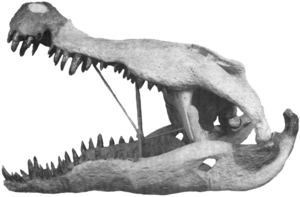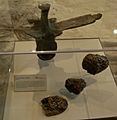Deinosuchus facts for kids
Quick facts for kids DeinosuchusTemporal range: Upper Cretaceous
|
|
|---|---|
 |
|
| Reconstructed skeleton at the Natural History Museum of Utah | |
| Scientific classification | |
| Kingdom: | |
| Class: | |
| Infraclass: | |
| Order: | |
| Suborder: |
Eusuchia
|
| Superfamily: |
Alligatoroidea
|
| Genus: |
†Deinosuchus
Holland, 1909
|

Deinosuchus is an extinct relative of the alligator which lived 80 to 73 million years ago, in the Upper Cretaceous period.
The first remains were discovered in North Carolina in the 1850s, but it was not until 1909 that the genus was named and described.
Additional fragments were discovered in the 1940s and were later made into an influential, but inaccurate, skull reconstruction at the American Museum of Natural History. Knowledge of Deinosuchus is still incomplete, but better skull material has been found in recent years.
Deinosuchus was far larger than any modern crocodile or alligator: it was up to 12 m (39 ft) and weighed up to 8.5 metric tons (9.4 short tons). However, its overall appearance was fairly similar to its modern relatives.
It had large, robust teeth that were adapted to crushing, and its back was covered with thick round bony plates. One study suggests that Deinosuchus may have lived for up to 50 years, growing at a similar rate to that of modern crocodilians, but growing for a much longer period.
Deinosuchus fossils have been found in ten U.S. states, as well as northern Mexico. It lived on both sides of the Western Interior Seaway, and was an ambush apex predator in the coastal regions of eastern North America.
Deinosuchus reached its largest size in its western habitat, but the eastern populations were far more abundant. Opinion remains divided as to whether these two populations represent separate species. Deinosuchus was probably capable of killing and eating large dinosaurs. It may have also fed upon sea turtles, fish, and other aquatic and terrestrial prey.
Images for kids
-
A Deinosuchus jaw fragment, exhibited at the North Carolina Museum of Natural Sciences: Fossils of this large alligatoroid have been discovered in 10 U.S. states and northern Mexico.
-
Deinosuchus may have preyed upon large ornithopods. Kritosaurus lived alongside the giant crocodilian in the Aguja Formation ecosystem.
-
Deinosuchus scutes and vertebra, Carnegie Museum of Natural History
See also
 In Spanish: Deinosuchus para niños
In Spanish: Deinosuchus para niños






